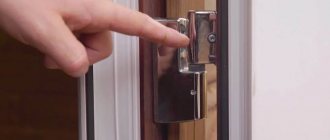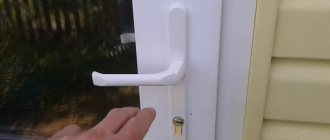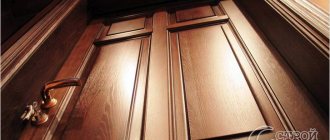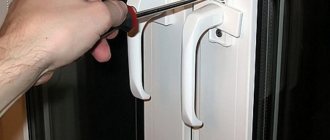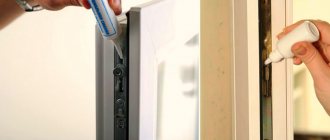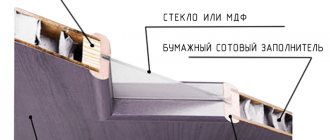Greetings to all blog readers!
Today we will talk about adjusting the PVC door on the balcony. A lot of my friends complain that there is a draft through the door, it doesn’t close tightly, and a bunch of other problems. I have to go and figure out what happened there.
In fact, there is only one reason - improper care of the fittings and rubber seals. Every time we have to explain what needs to be done, how to care for the door. In this regard, I decided to write instructions for everyone, in case you have the same problem and cannot find a solution.
What you need to know about adjusting a plastic door
Today, metal-plastic balcony blocks are installed in almost every apartment. As you know, both windows and doors can wear out over time. Most often, it is plastic doors that require repairs, because in just one day they can be opened and slammed countless times.
At the same time, the door weighs more than the window frame, therefore it is easier to deform, and sometimes it “slips” when the structure is lowered. There is a need for urgent repair of the sash.
To adjust a faulty balcony door, generally the same principle is used as in adjusting a window mechanism. However, door repair has a number of characteristic properties. We will talk about problems that may arise during the operation of plastic doors and ways to solve them in this article.
First of all, when starting to adjust the door, you need to stock up on screwdrivers (regular flat-head and Phillips), as well as a 4 mm wrench for adjusting the screws on the door hinges, and pliers.
Sometimes it happens that the plastic door to the balcony does not close. This problem usually occurs due to sagging door hinges or broken hardware, in particular the lock. Often the sash itself becomes deformed. In this case, you need to find out the cause of the malfunction, and only then begin repairs.
If the door with its lower structural element, when trying to close it, clings to the threshold, and it must be lifted, holding on to the fittings, it means that the door has dropped under the weight of its own weight. Due to the impressive size of balcony doors, such misalignment often occurs. If the door touches the frame in the center, we can talk about a horizontal displacement of the sash or a change in its shape.
This sometimes happens when exposed to high temperatures. Sometimes the mechanism that presses the sash to the frame breaks. As a result, the door frame remains slightly closed and does not lock even when the handle is turned. This problem can be resolved by repairing the clamping mechanism.
Preventive maintenance of balcony structures
In order for a plastic balcony door to serve for a long time and properly, it is necessary to properly care for it. First of all, it is necessary to adjust the clamping mechanism twice a year - in spring and autumn. With the onset of summer it is weakened, and with the onset of cold weather it is strengthened so that the sash fits tightly to the frame.
In order not to adjust the structure too often, it is recommended to install a microlift, which will prevent the doors from sagging. This is especially true if the door is equipped with a heavy double-glazed window.
In most cases, if the plastic door to the balcony does not close, you can fix the problem yourself, but if the problem is serious, then you need to entrust the matter to professionals who will quickly and efficiently fix the problem.
Adjusting the balcony door fastening mechanism
If the structure sags, the upper door hinges are adjusted first.
It is necessary to fully open the door, set the product to the rotation position, then release the fastening element from the decorative cap (in general, on all metal-plastic doors, the hinges are covered with special caps, and it is under them that the screws are hidden).
After this, using a spanner, tighten the adjusting screw to the right several times. This will correct the crooked position of the structure and prevent it from sagging again. It happens that in order for the sash to rise, it is also necessary to tighten the hinges from below. They have top and side screws.
The door can be raised a few millimeters by adjusting the top end screw. If you turn the side screw with a key, the sash tightens or, on the contrary, moves away from the opening.
Thus, the sagging is eliminated by rotating the adjusting screws on the hinges in the lower and upper parts of the door leaf. They are designed to allow the sash to be slightly moved in one direction or another.
What tools are needed for adjustment
To adjust balcony or entrance plastic doors, take the following tools.
- Hexagons with a diameter from 2.5 to 5 mm.
- Tape measure or centimeter.
- Phillips and flathead screwdrivers.
- Passages.
- Machine oil for lubrication of moving elements.
- Plastic linings.
We offer step-by-step instructions on how to set up a plastic door.
If you bought the door recently and the warranty period has not yet expired, contact the company that installed the door. They will carry out repair work for free.
What to do if the canvas touches the frame when opening
In this case, the door with its upper border can touch the frame. This indicates that, when adjusting the sagging, the sash was shifted to a greater height than necessary. It is easy to fix this problem: just turn the end screw once in the lower hinge. Sometimes the door cannot be closed completely, and the resulting gap allows cold air to pass through.
To avoid drafts, the sealing material should be changed. To do this, we purchase a suitable sealant at the construction market or in a store.
Using a screwdriver, release the groove from the old profile, then clean it of dried glue and wash it with a damp sponge or cloth.
Then you need to let the groove dry, then apply a layer of glue and attach the new profile with the fastening side. In this case, the cord or insulation material must not be pulled. It must be carefully smoothed out with your hands or a special copper tube with a curved end. The ends of the profile must be firmly glued.
So that balcony owners do not have to frequently change the sealing cord in the future, it is recommended to treat it with a special silicone mixture. You can usually purchase silicone for lubrication from the supplier of the balcony block system.
The handle for the plastic balcony door deserves special attention.
Deformation of locks and fittings is a fairly common problem. Sometimes, the door handle does not make a full rotation and requires force to do so.
Such a malfunction can be eliminated by using horizontal door adjustment. In this case, you can specifically press the door leaf more tightly in the direction opposite to the hinges before the start of the cold season. This is fine.
However, in the spring it is better to reduce the force of the pressing sash mechanism, since this causes it to break faster and also wears out the sealing profile. In situations where the handle is severely damaged, it is better to replace the deformed structural element with a new one.
If the handle is loose and turns too easily, you need to rotate the bar at the base 90 degrees. There are screws underneath that need to be tightened. This simple procedure will quickly solve the problem.
More on the topic What you need to know before insulating a loggia and balcony with your own hands
In order to check whether the balcony door has been adjusted correctly, let’s try to close the sash. If this happens easily, with light pressure on the handle, then the adjustment has been completed correctly.
Door handle adjustment
Very often you have to deal with the correct adjustment of the handle. However, before adjusting it, you need to familiarize yourself with the list of tools that may be useful for this.
To work with balcony doors you will need the following:
- Screwdrivers. It is recommended to prepare flat and cross-shaped tools in advance, with which you can tighten the handle or hinges. Their size must be selected in accordance with the characteristics of the fittings.
- Hexagons. The most commonly used are socket wrenches. However, in some cases, triangular and pentagonal products may be useful.
- Glue and scissors. May be needed if you need to replace a damaged rubber seal on the bottom.
Pressure adjustment is carried out using a hexagon
After preparing all the necessary tools, you can begin to inspect the handle and adjust it.
If it begins to constantly jam and does not turn, then most likely the cause of this problem is a malfunction of its internal mechanism. In this case, you will not be able to repair it yourself. The only thing you can do is buy a new pen.
If the handle does not jam, but simply dangles, it can be adjusted independently. To do this, use a flathead or Phillips screwdriver to tighten the mounting screws. At the same time, they must be tightened as tightly as possible so that the handle begins to be tightly fixed to the door leaf and stops dangling.
It is recommended to regularly tighten the handle so that it does not dangle too much. The fact is that it is gradually becoming loose. Especially if the doors are used very often.
Elimination of microdefects, scratches and chips
Over time, small cracks and damage may appear on the surface of the balcony door. To get rid of them, use a special mixture called “Cosmofen” or any other component similar in composition. It should be applied to visible areas with defects and wait until the surface dries.
After this, a special substance – plastic in liquid form – is also applied to the chips. For doors with lamination, a wax pencil or a so-called furniture touch is suitable. Sometimes repairing a balcony opening can only be done by contacting a specialist.
This applies to such defects as the appearance of cracks and chips in the glass unit, holes in the plastic, and destruction of welds. This may cause the door hinge mechanism to break. In some cases, it is even necessary to order the production of a new door or call a repairman.
Occasionally, when adjusting the overlap, it becomes necessary to move the glass unit. Using the adjusting screws you can move the door a few millimeters. If you need a larger offset angle, you need to combine both types of adjustment - screws and moving the glass unit.
The glass unit is secured with rods. They should be removed, and then squeezing blades should be placed under the glass unit, which will act as a lever, and with their help, move the glass unit in the desired direction. In this case, the spring effect begins to act and the plastic door moves along with the double-glazed window.
After adjustment, you need to secure the glass unit again with rods. These fasteners are different sizes for different parts of the structure, so you need to be careful not to mix them.
Tips for use
Small defects (small cracks, damage) that appear on a metal-plastic profile during long-term use can be eliminated if you use special means: Cosmetic phone, liquid plastic, wax pencil for laminated surfaces. Larger cracks in the PVC profile, damaged double-glazed windows - such deformations are corrected by specialists.
You can avoid serious problems in the operation of the door if you regularly perform maintenance: clean and lubricate the seal, adjust the fittings, monitor sagging and movement of the sash. Any movement of the door will eventually lead to difficulties when closing, which means that periodic adjustment will save you from serious problems in the future.
Balcony door fixing
In some cases, it becomes necessary to completely remove the sash. For example, to carry out complex repairs or when it is necessary to leave the opening open when exiting to the balcony in order to remove large pieces of furniture there.
First, remove the special cap covering the top loop. Then the axial rod (pin) is pressed. The pressure should be on its head, which rises above the door hinge. Using pliers, you need to hold the pin from below and also pull it out to the end.
The next step is to tilt the structure towards you and lift it slightly, 5–6 cm is enough. This procedure removes the fasteners from the bottom hinge, which allows you to remove the door and move it if necessary.
After some time, the sash needs to be put back in its place in the opening. The installation of plastic doors on a balcony is carried out in several stages: The lower hinge is placed on a rod for fastening with a special hole. The door is then installed in its working position.
With proper pressure on the top hinge pin, it will take its original position, protruding 5 mm from both sides of the hinge. Finally, the decorative hinge attachments should be put back in place.
Do not forget about the large weight of plastic balcony blocks.
The sash is quite heavy. If you drop it during dismantling, the hinge mechanism will break. In this case, you will either have to buy a new door, or seek help from professionals, experts in installing balcony blocks. In order to avoid such troubles, it is better to remove and hang the door by inviting an assistant.
Often, the installation of a metal-plastic balcony system is identical to the installation of any standard interior panel or sash. However, the opening method makes a significant difference here. This determines the specifics of the installation. It is carried out in stages.
First you need to remove the old ceiling. The next step is to clean the doorway. It is necessary to sweep away the remaining debris and wipe the sides of the hole in the wall from dust. Then you can proceed directly to installing the door frame.
Moreover, if sliding products are being installed, it is necessary to attach guide profiles. The remaining gaps are filled with polyurethane foam, after which the door is put on the hinges. At the end comes the turn of fittings and adjustment of the handle.
As a rule, when purchasing a balcony door, they issue a guarantee. While the warranty period has not expired, it is better to use the services of a specialist for installing plastic windows and doors. Some defects and malfunctions are difficult to eliminate on your own.
In addition, if you additionally damage the door during adjustment or repair, you will no longer be able to count on the warranty and free troubleshooting.
You can set up a balcony door if it begins to function poorly with your own hands. However, you need to approach this process wisely so as not to accidentally damage the structure. Therefore, the main thing in installing and adjusting plastic doors to the balcony is strict adherence to the technology, accuracy and attentiveness when taking measurements.
If you make a mistake somewhere during the installation process, the door may begin to sag, bend, and simply not work well. Sometimes when adjusting a balcony door, the locking mechanism is destroyed. In this case, you need to replace it with a new one.
Source: zonabalkona.ru/dveri/ne-zakryvaetsya-plastikovaya-dver.html
How are latches installed?
It is better to leave the installation of any type of fittings to professionals: they will do the work at the stage when they install the window and door unit. This case is ideal, so the owners of the balcony most often do the retrofitting on their own, already during the operation of the door.
The simplicity of magnetic and roller latches makes it possible to perform the operation relatively quickly, but efficiently. Before such work, first check the door to ensure that the door is in the correct position and that there are no distortions. If even small errors are found, they are adjusted.
Installation of the roller mechanism
The first step in installing such a latch is securing the roller to the end of the door leaf. The devices are available in two sizes - 9 and 13 mm. A sales consultant will help you choose the right fittings if you name the door manufacturer. The sequence of work with different roller models is the same.
- The latch on the balcony door is always installed near the handle to avoid unnecessary effort when closing the door tightly. Therefore, the first thing to do is unscrew one of the screws securing the fittings.
- Then a roller is attached in its place. Since this element protrudes relatively far beyond the canvas, the fastener must be of sufficient length, but choosing a screw that is too large is dangerous: it can damage the glass unit.
- After installing the roller, markings are made for the strike plate. Using a ruler applied horizontally to the center of the roller, the mark is transferred to the front part. After closing the door, this point is marked on the frame.
- Having aligned the center of the hole of the strip with the resulting mark, the latch is first screwed with one self-tapping screw (19 mm) - from the top. Then they check the operation of the mechanism: the door is closed and opened several times.
- If no obstacles are found, then screw in the lower fastening element. When the mating part is displaced, errors in distance are determined, and the mating part is dismantled. It is again fixed in a new place, but now with the problematic, bottom screw, and checked again.
The last stage of work is the final installation of the strike plate - tightening the top screw.
Mounting the magnetic latch
Installation of the magnetic mechanism is done in a similar way, but this work is much simpler.
- First, unscrew the screw closest to the handle in the same way. A steel bar is fixed in its place. Since its thickness is approximately 1 mm, the fastener is not changed to a longer one in this case.
- The doors are covered, the upper and lower boundaries of the strip are marked on the frame. Then the counter magnetic part of the mechanism is attached to the frame.
Both types of installation are simple and will not take much time from the master. The main thing for him is attentiveness, since the accuracy of the markings will help him “hit the target” on the first try.
Installation of the "smoker's handle"
The shell-petal handle is mounted on the door in the same way. For a sash with a magnetic lock, its absence is not critical, but for a mechanical roller latch it is necessary. The work takes a minimum of time:
- first they look for a suitable place on the door, optimally located on the same level with the internal balcony handle;
- The product is secured with self-tapping screws, their maximum length is 10 mm.
Using longer fasteners is undesirable, even dangerous: the consequence may be damage to the glass unit.
When adjustment of a plastic balcony door is required
The price of a plastic balcony door is quite high, but buying an expensive high-quality model does not save you from frequent cases of mechanism breakdowns. It's all about its frequent use, which leads to a decrease in the tightness of the sash.
In addition, double glazing provides excellent sound insulation, and PVC guarantees durability. However, it is these materials that noticeably make the structure heavier, as a result of which it begins to sag under its own weight and ceases to close tightly. As a result, a noticeable draft appears in the room, and insulating the balcony does not help.
The normal position of the plastic door is as follows:
- if the door is open, it does not move on its own;
- no sash displacement;
- the leaf is pressed tightly against the door frame profile.
If this is the case, intervention in the door mechanism is not required. However, if you notice the slightest deviation, you immediately need repairs to your plastic balcony doors. You shouldn’t delay calling a technician, because with each opening and closing the situation will get worse. As a result, this can lead to balcony doors not closing at all.
Helpful advice! If the door installation warranty has expired and you do not want to contact a specialist, you can watch a video of self-adjustment of plastic balcony doors and fix the problem yourself.
Advantages and disadvantages
The advantages include the following:
Plastic balcony doors are reliable protection from noise and cold for many years.
- beautiful appearance;
- high sound insulation;
- the possibility of micro-ventilation (if the door is made tilt-and-turn) - to provide fresh air in the room;
- they close tightly, so the room maintains a constant temperature;
- have anti-corrosion resistance;
- do not require additional finishing or painting;
- have a long service life - up to 30 years;
- easy to clean.
However, there are some disadvantages:
- open only inward, and only a bracket is mounted on the outside for closing;
- when installing them, a high threshold is made (if it is lower, cold air will penetrate into the room);
- their width should not exceed 1 meter, otherwise sagging cannot be avoided over time.
Despite the great popularity of plastic balcony doors in apartments and business centers, malfunctions may occasionally occur in their operation. You can fix many problems yourself. If this is problematic, call a professional to install plastic balcony doors.
Types of balcony door faults
If you adjust a plastic balcony door with your own hands, for the success of the repair it is important to determine the causes of the malfunction. Most often the problems are as follows:
| Type of malfunction | Cause of occurrence |
| Door sagging (when closing the door clings to the plastic threshold) | Most likely, the structure is too heavy, which leads to its displacement downwards |
| Hanging handle for balcony door | Usually the handle starts to dangle when the balcony door is opened very often |
| Plastic balcony doors do not close tightly (the leaf is not pressed tightly against the frame and you feel a draft) | As a rule, this is a symptom of a malfunctioning door handle or a misaligned door. |
| The door is shifted to the side (the door touches the middle of the frame) | Most often the problem is in the hinges; adjusting them will help eliminate the problem. This problem often occurs due to constant sudden temperature changes that affect the fittings for plastic balcony doors in case of insufficient insulation of the balcony |
To test the door for tight closure, slam the shutter with a regular landscape sheet of paper. Try to push the sheet around the perimeter of the door. If it moves easily, the structure has lost its density and needs adjustment.
Also evaluate the tightness of the seal: uneven pressure on the rubber usually indicates sagging. Determining the direction of displacement is simple: pay attention to the place where the seal is compressed and check whether there is a mark from the sash on it.
How to determine if a door leaf is skewed
If you suspect the structure is skewed, close the sash, and then draw a pencil around the perimeter of the closed door.
Open the door and compare its outline with the drawn line. The presence of unevenness indicates that the door is warped. For accurate results, use a building level.
Table of values for door leaf adjustment
Let's say, as a result of measurements, you find out that the width of the drawn strip is 8 mm (an error of 1 mm is permissible). This means everything is in order and the door is not warped. If the width of one strip is 12 mm and the other is 4 mm, this clearly indicates that the door is skewed by 4 mm.
Note! Sometimes it turns out that on the hinge side the width of the strip is 3-4 mm, and on the handle side 6-7 mm. Such indicators indicate that the door is narrowed by 4-6 mm - this is a manufacturing defect, and it makes no sense to move such a door.
Also check the width of the opening on all sides of the frame. The difference in measurements should not be more than 1 mm. Otherwise, the opening will have the shape of a barrel - this happens when installed incorrectly, when the middle of the frame is pulled towards the wall more than the top and bottom. Such errors also lead to loose clamping.
By measuring the width of the sash on all sides, you will determine the correct length of the impost. The difference between the three measurements should not be more than 0.5-1 mm.
If the indicators differ from the norm, the length of the impost differs from the required one and causes the door to skew.
Main design elements
Each door block has main and secondary parts. Before starting work, you need to understand what the design consists of and the operating principle of the fittings. Basic set of parts:
- frame made of PVC profiles;
- window and door sashes;
- hinges that ensure opening and tight fixation of the doors;
- a handle with a locking mechanism that secures the doors in the closed position;
- seals - necessary for a tight fit of the sashes to the frame;
- glass unit
The equipment can be supplemented with hydraulic or mechanical closers and other parts.
How to adjust a plastic balcony door: step-by-step instructions
https://www.youtube.com/watch?v=6Xsqtc9vmo4
To avoid mistakes or accidental damage to the glass unit of a balcony door (the cost of which is quite high), you need to figure out how to adjust plastic balcony doors correctly.
When carrying out work, it is not necessary to overpay for a specialist: you can adjust the balcony door yourself - video instructions can be easily found on the Internet.
To work you will need very few tools:
- hexagon;
- crosshead screwdriver;
- flat screwdriver.
Instructions and video: how to adjust plastic balcony doors when sagging
If you notice that when opening and closing the door it scratches the bottom edge of the frame, this indicates sagging of the door. The adjustment in this case can be vertical or horizontal.
Scheme of vertical and horizontal door adjustment
Horizontal adjustment steps:
- Open the door wide to the swing position.
- There is a screw located near the top hinge at the end of the sash. Take the hex key and turn it clockwise 2-3 times.
- Remove the plugs covering the holes leading to the top screws.
- Turn all screws under the plugs clockwise.
- After adjusting the mechanism, check whether the door now closes freely. If necessary, tighten the screws again.
To understand how to adjust balcony doors vertically, do the following:
- Lift the door evenly and find the screw at the bottom end of the hinge, located along its axis.
- If the screw is covered by a plug, carefully remove it.
- If you twist the screw clockwise, carefully lift the door, if counterclockwise, lower it.
Adjusting the pressure of balcony doors and door handles
To tighten the handle for a plastic balcony door, you need to do the following:
- Slowly and carefully turn the plastic cap at a right angle.
- Under the plastic cover, find the screws for fastening. Pull them up.
If the handle does not turn well, sometimes it is enough to lubricate the lock with a special material that does not contain resin or acid. In the event of a complete breakdown, you should buy a handle for plastic balcony doors, unscrew the screws, remove the old part and put a new one in its place.
Helpful advice! A good option is to install a magnetic latch on the balcony door. This will allow you to avoid too much impact on the door handle every time you close and open the door, which will have a beneficial effect on its durability.
Schematic instructions for self-adjusting the position of the balcony door
If there is blowing from plastic balcony doors, this is a sure sign that the sash is not pressed tightly. It is necessary to adjust the pressure of the plastic balcony door. To figure out how to adjust plastic balcony doors for pressure, look for locking elements on the door leaf. They are responsible for the pressure density.
Using a wrench or pliers, rotate the locking elements until the door is in the desired position. Professionals recommend periodically self-adjusting plastic balcony doors depending on the season.
Just figure out how to adjust plastic balcony doors for the winter, and you can easily loosen the pressure in hot weather and tighten it in the cold season.
Sometimes adjusting the hinges does not help solve the problem, and then the leakage of the clamp can be eliminated using a pin. To do this you will need pliers.
To achieve maximum door pressure, install the trunnion perpendicular to the profile. To, on the contrary, achieve minimal pressure, position the trunnion parallel.
Replacing the seal and adjusting the door when the frame is scratched
It may turn out that adjusting the door pressure did not bring the desired result. This happens because the rubber seal has worn out, and any adjustments to the door are pointless without replacing it. To do this you need:
- Pull out the old tires. This can be done without much effort and you won’t need any additional tools.
- Remove dirt from the inside of the groove.
- Place a new seal. Make sure that the side bend is at the end of the sash.
Helpful advice! To make work easier, remove the sash from the frame: this will allow access to the rubber gaskets from the hinge side. It is better to choose a seal from the same manufacturer as the installed doors.
If the balcony doors do not close well and touch the frame, scratching its center, follow these instructions for self-adjusting plastic balcony doors:
- Lower the sash to the bottom hinge.
- Insert the adjusting key into the side screw and tighten the sash.
- If the door position does not return to normal, repeat the procedure with the top hinge.
Eliminating a draft from the bottom of the door
In cases where the door does not fit tightly to the frame profile, the rubber seal may need to be replaced. Another reason is that the sash is not pressed firmly against the frame. This problem can also be resolved by adjustment.
But in this situation, the impact is on the trunnions (protruding elements in the end part of the sash profile). By turning them in different directions, you can strengthen or, conversely, weaken the pressure of the door to the frame.
If none of the above methods solved the problem of draft from under the door, you should change the seal. The old cord is pryed off with a screwdriver, the groove is cleaned and degreased.
How to adjust door pins
Before installing the new seal, glue is applied to the corner areas and a rubber cord is inserted. It should not be stretched or compressed too much, just as the seal should not be installed in sections; it should be continuous.
Prevention of malfunctions of balcony doors
If you had to build a house yourself, adjusting the balcony door fittings is more important, because you want the result of your work to last longer. To minimize the risk of future problems, try to follow these rules:
- a reputable manufacturer is a guarantee of good quality products, because in terms of durability and performance characteristics, the quality of the materials from which the door and fittings are made is of primary importance;
- when purchasing fittings, make sure that all selected parts are suitable for the type and size of the balcony door: keep in mind that modern fittings are designed for a weight of 100-130 kg;
- so that you don’t have to figure out how to tighten plastic balcony doors, make sure you have a special microlift: this compensator part prevents the door leaf from sagging under the influence of its own gravity;
- To prevent the door from sagging and the sash from jamming, it is worth installing a special additional tire that limits the opening of the door.
Helpful advice! The microlift is especially relevant in the case of double-glazed windows, which are distinguished by their impressive weight and size. The design of the microlift can be different, representing a small lever on the side of the sash or a roller at its bottom.
Also, even at the door installation stage, pay attention to the following points:
- Along the entire perimeter of the door frame, the frame should fit evenly and tightly against it.
- Opening and closing doors should be easy and effortless.
- When checking with a building level, it should be obvious that the structure is installed exactly vertically.
- There should be no drafts.
- If the door is installed level, in the half-closed position it should not open or close on its own.
Remember that adjusting the door yourself is possible, but requires attention, caution and careful diagnosis of problems.
Therefore, if you have a valid warranty on your balcony door, if you identify the slightest malfunction, you should contact specialists who will quickly determine the causes of the problems.
If you are sure that the malfunctions are due to manufacturing defects or installation problems, it is also better to turn to professionals - tightening the bolts yourself in this case will not correct the situation.
If you decide to adjust the door yourself, be sure to follow the instructions, and if you replace the fittings, choose products from the same company as your balcony doors.
Source: t-spectr.ru/kak-otregulirovat-plastikovuyu-balkonnuyu-dver-osnovnye-rekomendacii/
What to do in case of blowing
If the balcony structure is not pressed tightly and is sagging, this may cause blowing. As a result, not only the fittings will suffer, but also nearby surfaces (for example, condensation will accumulate). Checking the malfunction is quite simple. To do this, close the balcony door tightly and then proceed as follows:
- Insert a sheet of paper in several places, as described above.
- Light a match, draw it around the perimeter and watch whether the flame fluctuates or not.
- They pass their palm and try to feel if there is an air flow. This method only works if there is a large gap, as well as in windy weather. But it does not allow you to detect small deviations.
If the balcony sash has sagged a little, causing air to blow through the cracks, repairs can be carried out using a regular hexagon or pliers. You should proceed like this:
- Remove the caps and tighten the pairs of screws at the top and bottom. If the balcony structure has sagged a little, it can be moved in any direction up to 3 mm.
- Tighten the axles. In spring or summer, they need to be rotated in the o direction: as a result, the clamp will weaken.
- In winter, the trunnions are rotated to the o side to increase the pressure.
- Once the settings are complete, clean the rebate and other fittings using a sponge and regular detergent. Then wipe the surface dry with a clean cloth.
The trunnions are adjusted to increase or decrease the pressure
Window or balcony door does not close
Modern plastic windows are practical and easy to use. But quite often situations arise when, for unknown reasons, it is not possible to close a window sash or balcony door.
Similar problems usually arise with plastic windows that were installed ten years ago, due to the lack of highly qualified installers in those years, and, accordingly, mistakes were made when installing windows. But owners of modern plastic windows may also encounter problems with closing the sash/balcony door.
We hope that our article will help you understand the causes of this problem and possible solutions. There are situations when you can handle it on your own; in more severe cases, you should seek help from a specialist.
Balcony latches; characteristics, features, installation, problems
In order for the plastic door leading to the balcony to correctly fulfill its main purpose and best protect the interior from all kinds of noise from the street, as well as dust, the highest quality fittings are needed. It is known that the main elements of door hardware are the lock, handle and balcony latch. It is these details that are responsible for the long and convenient operation of the structure and comfort in use.
- Characteristics
- How to choose a balcony latch?
- Latch Features
- What problems might there be with the operation of the lock?
- DIY installation and latches
- Conclusion
- Similar articles
The window sash does not close
The sash is held on the bottom hinge. This situation occurs when the window opens in two positions at once. That is, you quickly turn the handle to the “open” position and pull the sash, but the mechanism does not have time to fully operate. You can deal with this problem yourself.
Solution: Turn the window handle to the tilt position, that is, “12 o’clock”. Press the window sash as tightly as possible and try to close the window.
Modern window fittings are usually equipped with an erroneous opening blocker. In this case, if the sash is sagging on the lower hinge, you must first unlock the handle.
At the end of the window sash, you need to find a spring element, press and hold it. In this case, it is necessary to move the window handle to the folding position. Press the sash firmly and close the window.
As a rule, these actions help to cope with the problem. If after these manipulations the window does not close, then you should not be zealous so as not to aggravate the problem. It is better to seek help from specialists.
The window sash sagged. The problem is typical for massive doors and doors that open often, or, conversely, open very rarely. In this case, the solution to the problem will be standard adjustment of window fittings.
Solution: Sequence of actions - remove the decorative trims from the window hinges; - find the adjustment holes. As a rule, they fit with a hex key; - adjust each of them; Adjustments must be made until the window sash begins to work without problems.
The sash is blocked by any object. Quite often it happens that this “blocking” item is a protective drainage strip. It is located outside the window sash in its lower part.
Solution: If it is displaced, then it is necessary to move it to its original position.
4. The handle is locked in the folding position. The situation is not simple, but solvable. In this case, the so-called “scissors” flew out of the grooves.
SOLUTION: First of all, you need to remove the window sash. Remove the decorative trims from the hinges and press on the pins, using wire cutters to remove them. At the top of the window sash, find the “scissors” that are attached to the hinge.
Press the spring element and turn the window sash until you see a groove where you need to insert the “scissors”. If the window handle turns to any position, then you've done it. You just need to hang the window sash in place.
What problems might there be with the operation of the lock?
If used for a long time, such fittings sooner or later begin to do their job poorly. Sometimes adjustments or even complete replacement are required.
If the handle does not turn well or you hear a squeaking sound, you must use a special lubricant.
Remember that it is not recommended to use other mixtures, since they may contain various aggressive resins and other substances that can damage these parts.
The main reasons for the breakdown of the handle and latch lock include:
- Poor care of products;
- Not careful operation;
- Wear of some fittings;
- Damage to the mechanism;
- Incorrect position of the door itself (misalignment);
- Poor quality materials.
Often, when such parts begin to do their job poorly, many resort to replacing them, but there is no need to rush into this. First check the elements for the presence of lubricant.
Sometimes just cleaning them and applying lubricant is all you need to avoid replacing them and save money at the same time. But when you notice wear and tear on some elements or a breakdown of one of them, it is advisable to replace them, since such repairs may be impractical.
Balcony latches must be given special attention, because they determine whether the door structure can cope with the load. Otherwise, this may lead to damage to both the latch and other elements of the door structure.
Balcony door won't close
The reason that the balcony door does not close may be: sagging of the sash, changes in geometry, malfunctions in the fittings.
Troubleshooting:
- The door clings to the frame in the middle part - the door leaf is displaced horizontally or deformed.
- The balcony door catches the threshold and to close it you need to lift the door - the balcony door sank under its own weight. A fairly common problem due to the large dimensions of the door.
- The balcony door does not close completely; there is a small gap between the frame and the sash that is blown through by air - the clamping mechanism is not functioning correctly; adjustment is necessary.
To eliminate the sagging of the balcony door, it is necessary to make an adjustment, that is, lift the sash and pull the upper corner to the hinge. We open the balcony door.
Using an adjusting wrench, turn the screw on the sash near the top hinge clockwise. Now you need to lift the door. To do this, we use the adjusting screws of the lower hinge. It is necessary to lift the door so that it does not touch the frame. A properly adjusted balcony door opens and closes effortlessly by simply pressing the handle.
If the balcony door catches the jamb in the middle part. It is necessary to move the sash closer to the hinges. Modern fittings allow you to do this without dismantling the door, through adjustment.
Adjustment of the balcony door begins with the side screw of the lower hinge. The adjusting key is turned until the lower corner of the balcony door is pulled in. By analogy, we adjust the upper hinge.
Adjustment of the pressure on the balcony door occurs by rotating the locking elements (the so-called trunnions), which are located at the end of the balcony door. The procedure must be performed using pliers or a wrench. The possible displacement of the trunnions is insignificant - up to 2 mm.
Source: okna-germanii.com.ua/stati/ne-zakryvaetsya-okno-ili-balkonnaya-dver/
Features of door hardware
Before we look at how to adjust plastic balcony doors, let's understand their design and operating principle. The main components here are: double-glazed windows, a metal-plastic frame and tilt-and-turn fittings. The latter is responsible for opening, closing and tilting the sash.
The design of plastic doors and windows is identical. The only difference is their size and location.
Balcony fittings are a belt mechanism located along the perimeter of the door leaf. Control is carried out by a handle, the rotation of which leads to the movement of cylindrical locks relative to the counter plates installed on the fixed frame. The canvas is attached to the frame with special hinges that can carry the load created by a heavy metal-plastic frame with double-glazed windows.
Tilt and turn fittings are manufactured in such a way as to ensure convenient operation and simple setup. products For this purpose, the mechanism is equipped with several adjusting bolts, which allow:
- increase or decrease the pressure of the canvas to the frame;
- lower or raise the sash;
- adjust the horizontal position of the balcony door.
Location of adjustment elements for the plastic balcony door
Adjusting the plastic door
Any mechanism requires repair or adjustment of its operation from time to time, and fittings for opening and closing a plastic door - even the highest quality ones - are no exception.
A door installation company is not always ready to provide this service, and if it does this, you will have to wait several days for the specialists to arrive. It will take much less time to adjust the door yourself - it requires minimal skills that anyone can master.
The seal is worn out
This problem may arise after 5 years of regular use of the door, but if preventive maintenance is not carried out, this time can be significantly reduced. The first signal indicating a loose door fit is drafts around the perimeter of the structure. Since the seal cannot be repaired, you need to remove the old one and go to a specialized store to purchase the same one.
You shouldn’t skimp on the seal, but buy a high-quality one from a German or Russian manufacturer, but under no circumstances a Chinese one.
Common problems, their causes and prevention
Let’s immediately make a reservation that you don’t need to adjust the door yourself or call a technician once every six months or a year “just in case.” The mechanism does not require preventive tuning, and if it works normally, then there is no need to interfere with its operation.
The most common problems encountered are:
- The sash rests on the lower edge of the frame (threshold). The main reason is the heavy weight of the sash. The glass unit, which makes up the main part of the sash, is quite heavy. And if it is two-chamber and with 6mm glass, then sooner or later the hinges will get tired under this weight, and the sash will drop a little.
- The sash touches the frame in the middle part. Lateral movement of the sash is usually caused by thermal deformation and is eliminated by adjusting the hinges. The sash does not fit tightly to the frame, allowing air to pass through. Most likely, the problem is in the pressure of the balcony door and its regulation using the appropriate locking parts.
The handle does not fit well and wobbles when rotated. This is the simplest case, and this problem can be fixed in a couple of minutes. At the same time, the frequency of door adjustments can be significantly reduced by taking some preventive measures that will help avoid problems.
The first thing you need to pay attention to when purchasing is whether the characteristics of the fittings match the weight of the sash. It is necessary to select fittings that can withstand a weight of 100-130 kg - as a rule, this is quite enough.
Another way to prevent sagging is to install a special compensator, which is also called a microlift. This element of fittings is simply indispensable for doors with large dimensions or double-glazed windows.
Microlifts come in different designs and can be made in the form of a roller at the bottom of the sash or a small lever on the side. In addition, a special tire that limits opening will help to avoid sagging or jamming.
If these measures were not taken on time or simply did not help, then you will still have to start adjusting the door.
The balcony door is sagging - what to do?
If the sash is sagging and touches the frame with its lower edge, then it - the sash - must be lifted and moved to the upper hinge;
To do this, you will need a 4 mm hexagon adjustment wrench. The algorithm of actions in this case is as follows:
- Place the sash in the swivel position (not for ventilation).
- Find the screw near the top hinge at the end of the sash and turn it with a key a few turns to the right (clockwise), then close the sash.
- The screws of some systems are designed not for a hex key, but for an asterisk key, so it is advisable to have one in your arsenal.
- Gain access to the upper adjustment screw by removing the decorative plastic caps from the lower hinge.
- Raise the sash by turning the adjustment screw at the top end of the hinge (also clockwise).
- Check the movement of the sash and, if necessary, repeat all the described steps.
Adjustment when touching in the middle part
In this case, you need to move the sash closer to the hinges. To achieve this, you must first move the sash to the bottom hinge by inserting a key into the side adjusting screw.
If this does not help, then you need to do the same with the upper hinge, the adjustment of which is described above. Usually this is enough to prevent the door from touching the frame.
Setting the pressure
There are locking elements on the balcony door leaf - it is with their help that the tightness of pressing the leaf to the frame is adjusted. Most fittings use locking parts in the form of eccentrics, so you can achieve optimal clamping force by rotating them with pliers or an adjusting wrench.
The strongest pressure is provided by the horizontal position of the eccentric, the weakest - by the horizontal position. The standard position with normal pressure is diagonal. Before starting the procedure, it is advisable to study the adjustment diagram on the manufacturer’s website.
Strong pressure is usually set on the eve of winter, and weak pressure - with the onset of warm weather. To press the sashes to the frame from the hinge side, you need to adjust the screws on the lower and upper hinges.
Handle adjustment
The handles often get loose, but this problem is very easy to fix. It is enough to tighten the screws that are located under the plastic cap of the base of the handle with a screwdriver.
To access them, you need to rotate the cap itself 90 degrees. If the play does not disappear after tightening the screws, then perhaps the cause of the problem is a crack in the handle body, and then it needs to be replaced.
As you can see, adjusting the door does not require any special knowledge, qualifications or sophisticated tools - you can put your plastic balcony door in order yourself.
About defects and warranty period
All doors made of metal-plastic are durable, but a very large number of factors interfere with their fate. These include the carefulness of the owners, the quality of the mechanisms, correct installation, and temperature conditions. A plastic door that does not fit tightly is one of the possible warning signs. But how can you understand that the sash works flawlessly, that it does not yet need the intervention of the owners or “servicemen”? In normal condition, a door should close or open without much effort, without rubbing the frame in the door.
The connection, uniform along the entire perimeter, is proof of the ideal condition of the plastic structure. Checking for gaps is quite simple: you will need a sheet of paper. They squeeze him between the door and the frame, then try to pull him out. If it takes some effort, it's ok. When areas are discovered where “anomalies” are present, the sash needs adjustment, since the geometry is broken. A candle or a burning match in a draft can also convince of the existence of a problem.
The third version of the defect test requires the presence of a simple pencil. If there is any suspicion of unevenness of the canvas relative to the frame, then close the door tightly and draw it around the perimeter of the door. The scale of the problem is then assessed by opening the balcony and looking at the resulting line. In this case, the level will come to the rescue.
If the warranty period has not yet expired, then the responsibility for adjusting the plastic structure is the prerogative of the service department of the company that installed the window and balcony unit. If there is a desire to make the adjustment yourself, then it is better to nip it in the bud.
Do-it-yourself work after the warranty has expired, on the contrary, is encouraged, since this procedure is quite simple. However, you must have instructions, as well as a minimum of tools. This set includes hex keys (usually 6 mm), you may need screwdrivers - flat, Phillips, and pliers.
Vertical adjustment
Doors with a tilt-and-turn system have a rather complex design. But they are easy to adjust. To ensure the correct vertical position of the door leaf, you need to operate the corresponding adjusting screws, which allow you to lower or raise the structure.
The procedure for adjusting a plastic door, entrance or balcony:
- Identify the cause of the problem and prepare tools (hexagon or special star wrench). It is important that the hinges have a consistent appearance, otherwise making adjustments will be problematic, if not impossible.
Hexagonal star key Source prom.st
Adjusting and strengthening the handle
If the handle jams or does not turn completely, the cause is usually a breakdown of the internal movement mechanism of the long rods located in the lining of the double-glazed window. Vertical adjustment of the frame does not bring success either. It is unrealistic to repair such a breakdown on your own; you need to call a specialist and completely replace the mechanism.
It’s not difficult to fix a loose handle yourself. To do this, you need to turn the decorative trim covering the fastenings under the handle. Exposed mounting screws or screws must be tightened tightly with a Phillips or flat-head screwdriver.
Recommendations for the use of metal-plastic blocks
If the metal-plastic balcony block is configured correctly, manufacturers guarantee its operational period of at least 20 years. But for a longer service life of the structure, it is necessary to ensure proper care.
It is not recommended to use aggressive detergents to wash the double-glazed windows of a balcony block. Rubber seals must be treated annually with silicone-based lubricants.
In order to prevent premature wear of the rubbing elements of the door structure, it is necessary to promptly replace the sealing rubber bands. It is recommended to periodically clean the fittings and closure mechanisms from dirt and dust and be sure to lubricate them.
How to adjust the balcony door with your own hands, watch the video:
